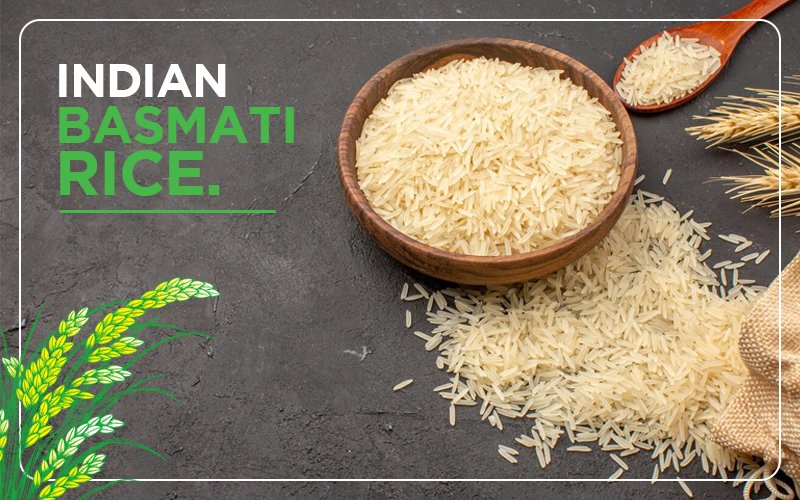
Indian Basmati Rice
Posted on February 3, 2024
Rice is a staple food in India and many other countries as well. It comes in various forms. One of these is the infamous Basmati rice. And Indian basmati rice is much in demand all around the globe. Indian basmati, a long-grain aromatic rice, isn’t just a staple food; it’s a cultural treasure. In addition, it’s a culinary ambassador for India and a crown jewel in the global rice market. It is known for its distinct fragrance, fluffy texture, and delicate flavor. These characteristics have captivated palates for centuries. Therefore, it is a top choice not just in the Gulf region but across the world.
Let’s dive deeper and understand the intricacies of this fragrant grain, its journey through the export market, and its role in the rice world. Here is an aromatic adventure for you.
Basmati: A Legacy Steeped in Fragrance and Flavor
The Basmati variety hails from the foothills of the youngest mountain chain, i.e., the Himalayas. It has been thriving for a long time in the unique climate and fertile soil of northwestern India and northern Pakistan. The name itself originates from Sanskrit, meaning “the fragrant one.” This clearly points toward a testament to its signature aroma. Basmati possesses slender and pearly grains. These grains elongate significantly upon cooking, thus retaining their individual form without any stickiness. Its delicate, nutty flavor and floral essence elevate simple dishes to gourmet heights.
Types of Basmati: A Spectrum of Delights
Now, basmati is not just a single variety of rice; rather, it’s a collection of a number of varieties. Each of these existing varieties offers its own nuances:
- Basmati 370: The classic, known for its long, slender grains. Along with its intense aroma and superior taste, This type dominates the export market, gracing countless tables across the globe.
- Basmati 385: A close cousin to 370, boasting slightly shorter grains but equally captivating fragrance and flavor. It’s popular in South India and finds favor in Biryani preparations.
- Pusa Basmati 1121: Developed by the Indian Agricultural Research Institute. This hybrid variety offers high yields and maintains the core Basmati qualities.
- Ranbirsinghpura Basmati: a heritage variety from Jammu and Kashmir. It’s prized for its unique sweetness and distinct aroma. Its limited availability adds to its mystique and high demand.
- Dehradun Basmati: Grown at the foothills of the Himalayas, this aromatic rice is known for its fluffy texture and earthy undertones.
From Field to Fork: The Basmati Export Journey
Indian Basmati is a significant contributor to the global rice trade. It has over 65% of the international market share. The export chain is well synchronized, ensuring the fragrant grains reach international tables in pristine condition. Let’s understand this journey:
- Cultivation: Skilled farmers tend to the basmati plants. They use traditional and modern techniques to produce high-quality crops. In addition, sustainable practices are increasingly being incorporated to ensure environmental protection.
- Processing: After harvest, the rice undergoes rigorous milling and polishing processes. This is done to remove the husk and bran, thus revealing the pearly white grains. Modern technological advancements ensure precision and efficiency.
- Grading: Stringent quality control measures come into play. Various parameters, like grain size, aroma, and moisture content, influence the final grade. Only the finest grades make it to the export market.
- Packaging: Basmati is typically packaged in vacuum-sealed bags or jute sacks to preserve its freshness and aroma during the long journey overseas.
- Distribution: A robust network of exporters, traders, and logistics companies ensures timely and efficient delivery to international markets.
Market Leader Beyond the Gulf:
The Gulf region is the primary importer of Indian Basmati rice. But it’s not just confined to the region; it extends far beyond. From European gourmet stores to American kitchens, fragrant rice has carved a special place for itself in the diverse culinary landscapes. Its versatility shines in various dishes. This ranges from simple steamed rice to intricate Biryani creations.
Authenticity: Treasured by Generations
The original Indian basmati rice has been treasured for generations. But there’s an increasing number of imitations and blends of the same. It thus indicates the importance of protecting the unique identity of Indian Basmati. Geographical indications (GIs) for specific regions like Dehradun and Basmati 370 safeguard the authenticity and heritage of this precious grain. Preserving these designations ensures that consumers experience the true essence of Indian Basmati, passed down through generations.
A Final Note: A Fragrant Legacy Continues
Therefore, to conclude, Indian basmati is more than just a commodity. It’s a cultural ambassador, a culinary treasure, and evidence of generations of agricultural expertise. Its journey from the fertile fields of India to international tables is a commendable story. This shows the dedication, innovation, and unwavering passion for quality. As the world’s appetite for this fragrant rice continues to grow, understanding its intricate journey, diverse types, and unwavering focus on authenticity becomes even more vital. In every fluffy grain, in every breath-taking aroma, lies a legacy waiting to be savored and protected. Let’s keep the fragrant heritage of Indian Basmati alive for generations to come.
